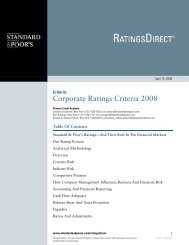European Infrastructure Finance Yearbook - Investing In Bonds ...
European Infrastructure Finance Yearbook - Investing In Bonds ...
European Infrastructure Finance Yearbook - Investing In Bonds ...
Create successful ePaper yourself
Turn your PDF publications into a flip-book with our unique Google optimized e-Paper software.
found in project and concession financing but in<br />
corporate securitizations of the aforementioned<br />
sectors as well.<br />
Question 4: Why is the business risk profile so<br />
important to the credit quality of infrastructure<br />
transactions that use accreting debt?<br />
A project rating is a composite of many factors.<br />
To narrow the analysis to two factors--business<br />
and financial risks--some straightforward<br />
observations can be made. The stronger the<br />
business risk profile, the weaker the financial risk<br />
profile (including accreting debt and swaps) can<br />
be to achieve a certain rating, and vice versa. To<br />
gauge the appropriate financial risk at investmentgrade,<br />
the prime focus should be on the<br />
underlying business risk. Accordingly, to assess<br />
whether at investment-grade an accreting debt<br />
structure is commensurate, it is important to<br />
understand the business risk first, hence the<br />
importance of the business risk to the rating.<br />
As we view accreting debt structures to be more<br />
aggressive, for a similar rating an accreting<br />
transaction would need to have other strengths to<br />
compensate for this credit weakness.<br />
The strong business risk profiles and generally<br />
robust cash flow streams of infrastructure assets,<br />
together with strong covenant packages,<br />
compliance with SPE bankruptcy remoteness<br />
criteria, and supportive structural features allow<br />
infrastructure projects to be more highly<br />
leveraged and use accreting debt compared with a<br />
corporate entity at the same rating level.<br />
A strong business risk profile for long-term<br />
concessions and infrastructure providers would<br />
include a combination of the following<br />
characteristics (the listing below does not imply<br />
any ranking of relative importance):<br />
• An essential or high-demand service;<br />
• Where user fees are involved, a high degree<br />
of demand inelasticity with respect to rate<br />
increases;<br />
• Monopoly or near-monopoly characteristics,<br />
or, alternatively, few providers in the<br />
industry with substantial barriers to entry<br />
and limited incentives for competition<br />
among these service providers;<br />
• A limited reliance on increases in volume<br />
growth rates (for example, market exposure<br />
to traffic, parking activity, tonnage, or<br />
maritime containers), and aggressive<br />
STANDARD & POOR’S EUROPEAN INFRASTRUCTURE FINANCE YEARBOOK<br />
PROJECT FINANCE/PUBLIC-PRIVATE PARTNERSHIPS<br />
assumptions of price inelasticity to rate or<br />
tariff increases to meet base case revenue<br />
projections;<br />
• A favorable legal environment and<br />
regulatory regime;<br />
• Limited government interference probability,<br />
either through public policy changes and/or<br />
change-in-law risk;<br />
• A favorable rate-setting regime, although we<br />
recognize that it is rarely unfettered and,<br />
even then, can face challenges or political<br />
contention;<br />
• Strong bargaining power in relation to<br />
suppliers and customers;<br />
• Low, contained, or manageable ongoing<br />
capital expenditure requirements;<br />
• Strong counterparty arrangements with, for<br />
example, contractual offtaker agreements or<br />
remittance of payments from a highly rated<br />
public sector entity;<br />
• Strong historic track record of the asset. To<br />
this end, a project that is exposed to<br />
greenfield or start-up operations with no<br />
usage history (for example, a complete<br />
reliance on independent consultant<br />
projections) would be considered to have a<br />
weaker business risk profile; and<br />
• Proven technology for construction and<br />
major maintenance activities, as applicable.<br />
Question 5: Do you differentiate between<br />
the forms of debt increase in an infrastructure<br />
transaction?<br />
<strong>In</strong> our credit evaluation of long-term concessions,<br />
we attempt to understand the economic substance<br />
and evolving profile of the debt structure: its rise<br />
and repayments over time relative to the business<br />
risk profile of the project and the term of the<br />
concession. The project debt balance could<br />
increase based on a contractually agreed to<br />
schedule. Alternatively, the debt balance could<br />
vary based on required cash flows procured from<br />
an alternate financing source to meet debt service<br />
requirements and equity distribution targets.<br />
Finally, the project debt could rise due to a direct<br />
contractual link to an inflation index that<br />
increases during the term of the debt.<br />
Standard & Poor’s has observed several forms<br />
of debt instruments that can cause a project’s debt<br />
to increase early in a concession and result in<br />
overstated traditional DSCRs. For comparative<br />
NOVEMBER 2007 ■ 107



